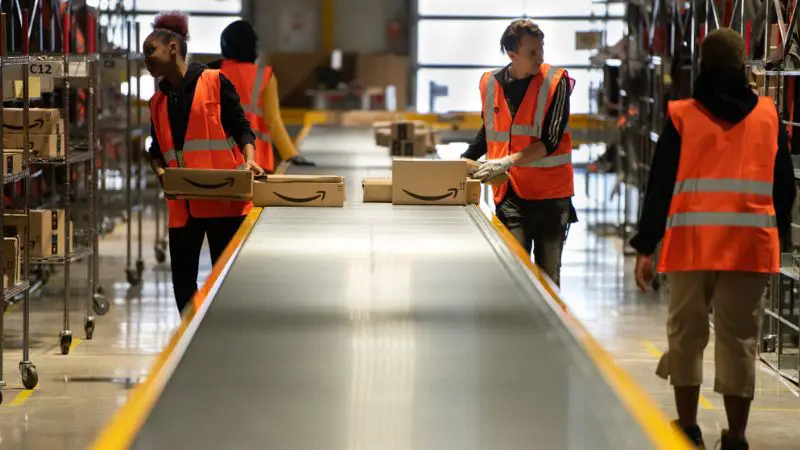Amazon has chosen a hierarchical organizational structure for its warehouses. In this article, we will cover exactly which roles are a part of the organizational structure at Amazon and who you should report to in each role.
Amazon Warehouse Organizational Structure
Amazon warehouse workers report to level 5 managers, also known as the front-line manager. The level 6 manager oversees all teams run by L5 managers. L7 managers work with inbound and outbound activities, while the L8 manager is the general manager of the Amazon fulfillment center.
Keep reading to learn more about Amazon warehouses and their organizational structure!
Is the Organizational Structure of Amazon Fulfillment Center Good?
Whether the organizational structure of Amazon fulfillment centers is good or not really just depends on who you ask. Some employees may like it; others may not care for it at all.
However, if we just look at it through the eyes of efficiency, it does appear as if the system that Amazon has in place is quite good. Employees are able to work together in their separate sections of the facility to ensure that customers get their packages on time — and very quickly.
Employees of different levels all partake in ensuring that the efficiency of the warehouse stays high. Warehouse employees will work as pickers and packers, while there are also employees who work to deal with inbound and outbound shipments.
There are also robots in the Amazon warehouse, as well as machines, that help this system run very smoothly — or as smoothly as possible.
Finally, there are managers (also of various levels) that help to manage specific teams on the warehouse grounds, as well as the entire warehouse itself.
Which Positions Are at the Top of the Hierarchy at Amazon Warehouse?
Let’s talk about the managers at Amazon warehouses, starting with L5 managers. An L5 operations or area manager is basically a front-line manager.
L5 managers work the entire shift with a specific team. For example, there will be one L5 manager for pickers during one shift. At the same time, there will be another L5 manager for the packers during another shift.
These managers are there on the ground, ensuring that everything runs according to plan. If things fall apart, they work to try to fix these issues.
An L6 Area Manager oversees an entire process — picking, packing, etc. Therefore, these managers may be overseeing quite a lot of employees, as well as lower leveled managers.
L7 managers are Senior Operations Managers. Their responsibilities can vary, though they often deal with either inbound activities or outbound activities.
The L8 manager is the general manager of the entire fulfillment center — and the highest employee there in the warehouse. They oversee absolutely everything. The L7 manager directly speaks to them and answers to them, though all other managers do as well.
Read more about the difference between Level 5 and Level 6 at Amazon.
How Long Time Does It Take to Reach the Top of the Organizational Chart at Amazon Warehouse?
If you’re looking to grow with Amazon and be promoted, you could end up quite high on the organizational chart in an Amazon warehouse. Will you end up as an L8 manager? You never know!
Past employees differ on whether it’s easy to be promoted at Amazon or not. Some employees say that if you put in work and effort for a while, you will eventually begin to be promoted up to manager-level status.
Others, however, state that it’s incredibly hard to move up the chain at an Amazon warehouse. If you do move up, they state that it takes a long time, and you won’t get where you want to be for years.
So, while you can move up and be promoted at Amazon warehouses, you have to expect that it will take you years to continue to move up the chain to higher levels.
Has the Management Structure of Amazon Center Changed?
Amazon is a very interesting company for many reasons. One of the reasons why they’re one of the biggest companies in the world is because the business as a whole is willing to change and adapt to the times.
Therefore, the management structure of Amazon has changed slightly since its inception — and it will likely change and adapt again in the future.
However, the “levels” that employees and managers can find themselves at will probably remain unchanged. This level system has been in place for a while — and it doesn’t seem to be going away any time soon.
Does Amazon Have a Flat Organizational Structure?

Amazon uses a hierarchical organizational structure. This means that all employees report to somebody above them — and on it goes up the line. Eventually, the last person that every employee reports to is the CEO, Jeff Bezos.
Amazon uses a hierarchical organizational structure because of its size, as it’s quite a large company. While they have a lot of employees, they don’t actually have a lot of higher-up employees, so the hierarchical system is narrow towards the top of the structure.
Is Amazon Centralized or Decentralized Structure?
Amazon is considered a very decentralized structure. As a result, all aspects of Amazon’s company can run differently depending on where you are. For example, one warehouse in California may differ vastly in how it is run when compared to a warehouse in Texas.
Is Amazon a Functional or Divisional Structure?
Amazon has a divisional structure. Because Amazon has so many products and services, the divisional structure works best. This allows department heads to accurately survey certain departments to ensure that everything is running smoothly — rather than all departments.
Conclusion
Amazon’s warehouse is organized by inbound and outbound shipments, pickers, packers, and more employees working to keep things running. These employees are managed by fulfillment center managers, mainly from Level 5 to Level 8. All employees and managers work together to help keep the warehouse running smoothly

